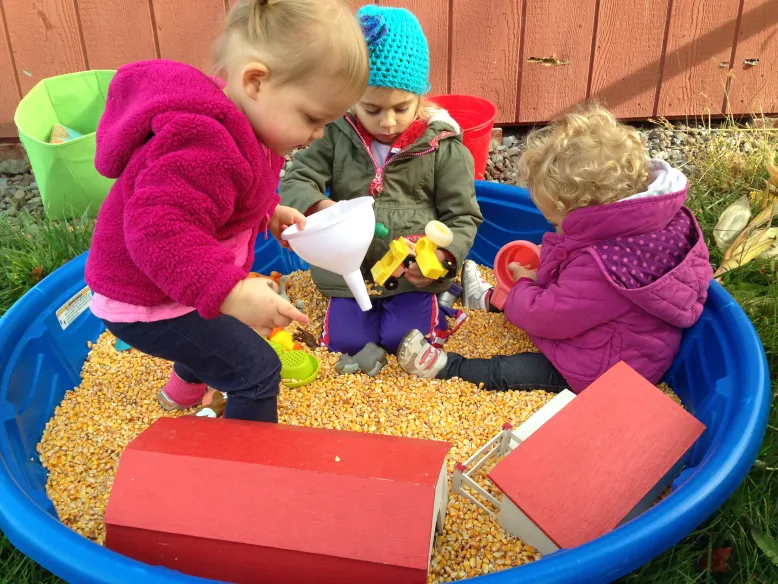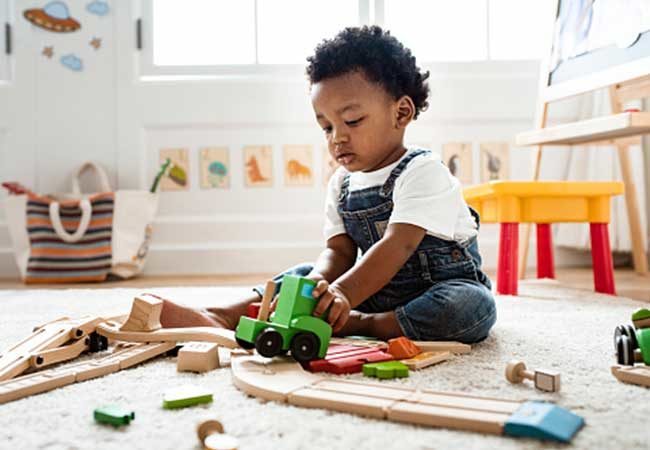Sensory play refers to activities that stimulate a baby’s senses: touch, smell, taste, sight, hearing, vestibular (balance), and proprioception (body awareness). These activities are crucial for early childhood development, providing a foundation for learning through exploration, curiosity, problem-solving, and creativity.
Importance of Sensory Play in Early Childhood Development Early sensory experiences help shape a child’s brain, laying the groundwork for cognitive abilities, language development, social skills, and emotional well-being. Sensory play encourages exploration and naturally helps children learn essential skills.
Overview of the Article This article delves into the various aspects of sensory play, its benefits, types, and practical ways to incorporate it into daily routines. It aims to provide parents and caregivers with comprehensive knowledge and practical tips to support their child’s development through sensory play.
What is Sensory Play?
Explanation of Sensory Play Sensory play is an activity that stimulates a child’s senses, helping them understand and explore their environment. It involves hands-on, play-based learning that is vital for developing neural pathways in the brain.
Types of Sensory Play Sensory play can be categorized into several types, each targeting different senses:
- Tactile Play: Activities involving touch.
- Auditory Play: Activities focusing on sound.
- Visual Play: Activities that engage sight.
- Olfactory Play: Activities that involve the sense of smell.
- Gustatory Play: Activities related to taste.
- Vestibular Play: Activities that develop balance.
- Proprioceptive Play: Activities that enhance body awareness.
Examples of Sensory Play Activities Some common sensory play activities include:
- Playing with sand or water
- Finger painting
- Listening to different sounds or music
- Exploring different textures and smells
- Tasting various safe, edible items
The Science Behind Sensory Play
How Sensory Play Affects the Brain Sensory play is crucial for brain development. It helps create and strengthen neural pathways, which are essential for cognitive processes such as thinking, learning, and understanding the world around us.
Neuroscience of Early Childhood Development Research in neuroscience shows that sensory experiences are fundamental in early childhood development. These experiences help the brain form connections that support learning and memory.
Sensory Play and Cognitive Development Sensory play supports cognitive development by enhancing problem-solving skills, promoting language development, and improving memory and concentration. Engaging in sensory activities helps children understand cause and effect, develop reasoning skills, and enhance their ability to focus.
Physical Benefits of Sensory Play
Enhancing Fine Motor Skills Sensory play activities, such as manipulating small objects, help develop fine motor skills. These skills are crucial for tasks like writing, buttoning clothes, and using utensils.
Gross Motor Skills Development Activities like running, jumping, and climbing improve gross motor skills, which involve the large muscles of the body. Sensory play often incorporates these movements, promoting overall physical development.
Coordination and Balance Sensory play that includes movement activities, such as balancing on a beam or spinning, helps develop coordination and balance. These skills are essential for physical activities and overall mobility.
Cognitive Benefits of Sensory Play
Problem-Solving Skills Sensory play encourages children to explore, experiment, and find solutions to problems. This process enhances their problem-solving abilities and critical thinking skills.
Language Development Through sensory play, children are exposed to new words and concepts, which aids in language development. Describing textures, colors, and actions enriches their vocabulary and communication skills.
Enhancing Memory and Concentration Engaging in sensory activities requires children to focus and pay attention, which improves their memory and concentration. These activities also help children develop the ability to stay engaged in tasks for longer periods.

Emotional Benefits of Sensory Play
Building Self-Esteem and Confidence Successfully engaging in sensory play activities boosts a child’s self-esteem and confidence. Completing tasks and mastering new skills provide a sense of achievement and pride.
Reducing Anxiety and Stress Sensory play can be calming and soothing, helping reduce anxiety and stress. Activities like playing with sand or water, or listening to calming sounds, can have a therapeutic effect on children.
Emotional Regulation Sensory play helps children understand and manage their emotions. It provides an outlet for expressing feelings and teaches them how to cope with different sensory inputs, aiding in emotional regulation.
Social Benefits of Sensory Play
Improving Social Interactions Sensory play often involves group activities, which help children learn to interact with others. These interactions promote social skills, such as sharing, taking turns, and cooperating.
Cooperative Play Many sensory activities require children to work together, fostering cooperative play. This type of play helps children learn teamwork, problem-solving as a group, and how to communicate effectively.
Communication Skills Through sensory play, children practice verbal and non-verbal communication. Describing what they feel, hear, or see, and responding to others, enhances their communication skills.
Types of Sensory Play
Tactile Play Activities involving the sense of touch, such as playing with different textures, sand, or water.
Auditory Play Activities that focus on sound, such as listening to music, identifying different noises, or creating sounds with instruments.
Visual Play Activities that engage sight, such as playing with colors, shapes, and light.
Olfactory Play Activities that involve the sense of smell, such as identifying different scents or using scented playdough.
Gustatory Play Activities related to taste, such as tasting different foods or playing with edible materials.
Vestibular Play Activities that develop balance and spatial orientation, such as swinging, spinning, or balancing.
Proprioceptive Play Activities that enhance body awareness, such as climbing, jumping, or pushing heavy objects.
Tactile Sensory Play Activities
Playing with Sand and Water Sand and water play are excellent tactile activities. They allow children to explore textures, temperatures, and the concept of cause and effect.
Finger Painting Finger painting helps children explore colors and textures while developing fine motor skills and creativity.
Sensory Bins Sensory bins filled with various materials like rice, beans, or pasta offer a tactile experience that promotes exploration and learning.
Auditory Sensory Play Activities
Music and Rhythm Games Listening to music and playing rhythm games help develop auditory skills and a sense of rhythm and timing.
Sound Matching Games Sound matching games, where children match objects with the sounds they make, enhance auditory discrimination skills.
Homemade Instruments Creating and playing with homemade instruments, like shakers or drums, provides auditory stimulation and encourages creativity.
Visual Sensory Play Activities
Color Sorting Games Color sorting games help children learn about colors, improve visual discrimination, and develop organizational skills.
Light and Shadow Play Playing with light and shadows encourages visual tracking, understanding of light sources, and creativity.
Visual Tracking Games Games that require children to follow moving objects with their eyes improve visual tracking and coordination.
Olfactory Sensory Play Activities
Scented Playdough Playing with scented playdough stimulates the sense of smell while also providing a tactile experience.
Smell Matching Games Smell matching games, where children match scents with their sources, enhance olfactory discrimination skills.
Exploring Natural Scents Exploring natural scents, such as flowers, herbs, and spices, helps children learn about different smells and their sources.
Gustatory Sensory Play Activities
Safe Edible Play Materials Using safe, edible materials for play, such as flavored playdough, allows children to explore taste and texture in a safe environment.
Taste Testing Games Taste testing games help children learn about different flavors and preferences, enhancing their gustatory sense.
Exploring Different Textures Exploring the textures of various foods helps children develop their sense of taste and touch simultaneously.
Vestibular Sensory Play Activities
Swinging and Spinning Activities like swinging and spinning develop the vestibular system, which is responsible for balance and spatial orientation.
Balance Beam Activities Walking on balance beams or other narrow surfaces helps improve balance and coordination.
Movement Games Games that involve moving in different ways, such as jumping, hopping, or rolling, enhance vestibular development.
Proprioceptive Sensory Play Activities
Climbing and Jumping Climbing and jumping activities enhance proprioception by helping children understand their body position and movement in space.
Heavy Work Activities Heavy work activities, such as pushing or pulling heavy objects, provide proprioceptive input and strengthen muscles.
Resistance Play Playing with resistance bands or engaging in activities that require muscle strength improves proprioceptive awareness.

Creating a Sensory Play Environment
Safe Play Areas Creating a safe play area with soft surfaces and child-proofing ensures a secure environment for sensory play.
Organizing Sensory Materials Organizing sensory materials in accessible and labeled containers makes it easy for children to choose and engage in activities.
Creating a Sensory-Friendly Space Designing a sensory-friendly space with calming colors, soft lighting, and minimal distractions promotes focused sensory play.
Choosing the Right Sensory Toys
Age-Appropriate Toys Selecting toys that are appropriate for a child’s age and developmental stage ensures safety and engagement.
Multi-Sensory Toys Choosing toys that engage multiple senses, such as textured balls or musical instruments, provides comprehensive sensory stimulation.
DIY Sensory Toys Creating DIY sensory toys using household items can be a cost-effective and creative way to provide sensory experiences.
Incorporating Sensory Play into Daily Routines
Morning Sensory Activities Incorporating sensory activities into the morning routine, such as playing with textured objects during breakfast, helps start the day positively.
Sensory Play during Mealtime Using different textures and flavors during mealtime engages the senses and makes eating a more enjoyable experience.
Bedtime Sensory Activities Calming sensory activities, such as listening to soft music or playing with a tactile toy, can help prepare children for bedtime.
Sensory Play and Children with Special Needs
Sensory Integration Therapy Sensory integration therapy helps children with sensory processing issues develop the ability to process and respond to sensory information.
Adapting Sensory Activities Adapting sensory activities to meet the specific needs of children with special needs ensures inclusivity and engagement.
Benefits for Children with Autism and ADHD Sensory play can be particularly beneficial for children with autism and ADHD, helping them develop sensory processing skills and manage behaviors.
Parental Involvement in Sensory Play
Role of Parents in Sensory Play Parents play a crucial role in facilitating and participating in sensory play, providing support and encouragement.
Encouraging Participation Encouraging children to engage in sensory play by showing interest and enthusiasm promotes a positive experience.
Observing and Responding to Child’s Needs Observing children’s reactions and adjusting activities based on their needs ensures a supportive sensory play environment.
Challenges and Solutions in Sensory Play
Common Challenges Common challenges in sensory play include sensory overload, safety concerns, and finding suitable activities.
Overcoming Sensory Overload Overcoming sensory overload involves observing signs of distress and providing calming activities to balance sensory input.
Balancing Sensory Stimulation Ensuring a balance of sensory stimulation involves offering a variety of activities and allowing children to take breaks as needed.
Research and Studies on Sensory Play
Recent Findings Recent research highlights the importance of sensory play in early childhood development, showing its impact on cognitive, physical, and emotional growth.
Case Studies Case studies provide real-life examples of how sensory play has benefited children, offering insights and practical tips.
Expert Opinions Expert opinions from child development specialists emphasize the value of sensory play and offer guidance on best practices.


